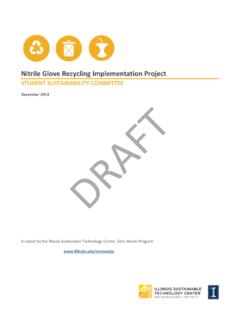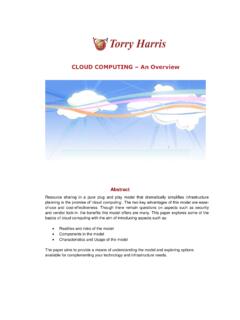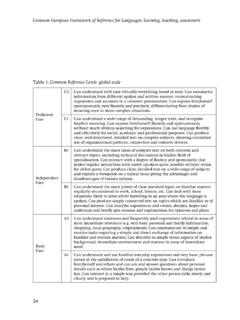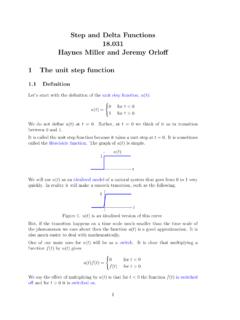Transcription of Renewables Comparison
1 Renewables ComparisonWind vs. Solar EnergyErwin Lavric, Sara Pattison, Haven Richardson, Carter WoodGoal of the project To determine whether wind energy or solar energy is a more efficient and sustainable alternative to coal energy for commercial use. Wind Energy and Solar Energy, but what are they?Solar energy is generated by: Solar panels-which are panels that absorb the sun s rays to be converted to generate electricity or heatWind energy is generated by: Wind turbines-which are turbines with a large vaned wheel that is rotated by wind to generate electricityAlternatives to Coal Energy:Solar TechnologyPhotovoltaic (PV) captures sunlight and converts it directly to electricity with panels made with semiconductor materials.
2 Concentrating Solar Power (CSP) systems use mirrors and lenses to focus the sun s light energy and convert it to heat. The heat creates steam which will turn a turbine creating energy. Wind TechnologyHorizontal Axis design are windmills with a long thin base and have 2-3 propeller-like blades extending outwards from the top of the windmill which rotate as the wind blows. The blades spin a shaft inside of the turbine and the moving shaft spins a generator to create Axis design include windmills that have their blades more parallel to the base so that they when they spin, it is about the base rather than perpendicular to it. Internally, vertical axis windmills generate electricity the same way the horizontal axis designs do.
3 Why Wind vs. Solar?Fastest growing renewable optionsNuclear/Hydroelectric only ~1% growthAlmost unlimited spaceOcean tethered turbinesScale flexibilityWhy Renewables ?Coal production downEnergy demand increaseCO2 emissions risingScopeThrough the analysis of Cost-Benefit Analyses, Life Cycle Analyses and other important impacts, we will be able to conclude whether solar power or wind power is commercially better suited to be a main source of energy in the to Consider Cost-Benefit Analysis Life-Cycle Assessment Durability Noise Location InnovationsFunctional UnitsCBACost per energy output (dollar/ kilowatt hours)LCACO2 per energy output (gram CO2 e/ kilowatt hours) . Cost Benefit AnalysisBoundariesNew Plant ConstructionOperation of PlantMaintenance of PlantAssumptionsCO2 abatement = $50 per metric tonSame cost of landBased on avoided emissions and avoided costsSame new plant used to process energy receivedTransmission lines same for both wind and solarConstruction takes yearsCBACO2/MWH.
4 Fossil Fuel PlantsBaseline reductionUsed coal for comparisonDifferent fossil fuels have different carbon emissionsCBAA voided Emissions Capacity% of time online (nationwide)On/off peak timesDemand high during dayStorage needed for off-peak92% for gas turbineNothing at 100%CBAE nergy Cost per MWHNo cost for sun and windO&M minimalBased on capacityEnergy Information AssociationOverall Net BenefitsWindSolarAvoided Emissions$284,526$185,338 Avoided Energy Cost$98,925$67,732 Avoided Capacity Cost$70,482$46,425 Fixed Cost Incurred$-162,687$-181,434 Other Costs(Periodic O&M)$-7,755$-4,713 Total Net Benefits/MW/Year$283,311$113,349 Wind Power 2013 StudiesElectric Markets and Policy Group (Berkeley) Energy Information AssociationAmerican Tradition InstituteData SourcesElectric Markets and Policy Group (Berkeley)-Market report-Wind power Energy Information Association-Independent source/ 3rd partyAmerican Tradition Institute-Right wing nonprofit-Fought against global warming fear mongering Brookings Institution (Princeton)
5 -Focuses on Global Economy and DevelopmentLife Cycle AssessmentBoundariesLife Cycle Assessment Life Cycle Assessment Harmonization ProjectLife Cycle Assessment New Solar InnovationsSistine SolarSolar skinElon MuskRoof panelsDouble-sided panelsUse of Boron instead of AluminumNew Wind InnovationsOffshore wind technologies According to National Renewable Energy Laboratory, there is a gross wind power resource of 4,223 GW/year off the coast of the United States58% of US wind resources are located in regions too deep for regular foundationsBladeless Wind TurbineTakes advantage of vortex of wind created when air moves around an objectMade of carbon fiber and fiberglassMotor at the base to improve stabilityCompletely silent and birds are free to fly around themDurability/ MaintenanceWindVaries greatlyGearbox type requires annual maintenanceDirect drive needs very little maintenancePredicted 20-25 year life spanSolarMinimal maintenancePredicted 30 year life span80% power after 20 yearsLocation/ integration OptionsSolar Few limitations to location Can be mounted nearly anywhere Must be
6 Facing the SunWind Must be 30 feet above anything within 500 feet very unfavorable in urban areasLocation/ integration OptionsLocation/ integration Options*Department of Energy, 2014 Solar Cost/kwh by Location*DOE 2016 reportNoiseSolar Completely silent during operationWind At high wind speeds, small turbines operate around 100 dB Can potentially be bothersome if near housesConclusionsWind more carbon efficientWind more cost effectiveLocation very impactful on implementationSolar growing at a faster rateSourceProduction Growth 2014-2015 Generation (GWH/Year) Information Associatio









